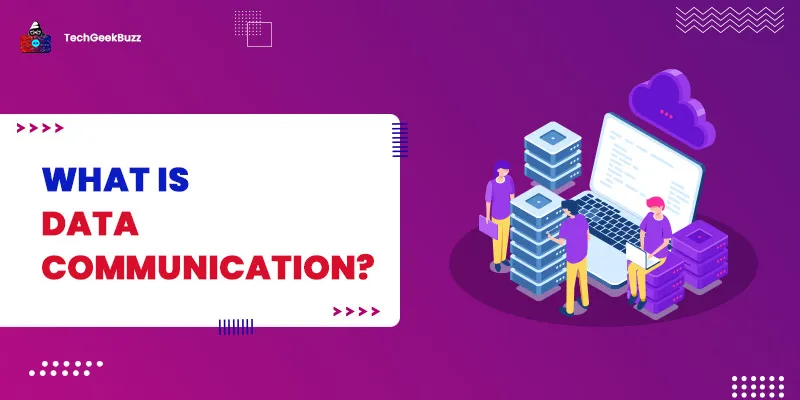Communication has become easier and more effective these days than ever before. Also, the exchange of data has become more manageable and quicker due to digital networks.
In general, communication is the process of exchanging information. For example, a conversation between two individuals is communication.
But what about data communication? Well, data communication is simply the transfer of data from one device to another. Some common examples of data communication in our daily life are electronic mail, Facsimile or fax, cell phones or mobile phones, internet and intranet , and extranet.
Through this article, we will make you familiar with data communication and its various components.
So, let us start our discussion!
What is Data Communication?
There are two terms in ‘data communication’, namely data and communication. Data can be anything, such as text, audio, videos, images, and multimedia files, and communication is the process of sending or receiving data. Therefore, the terms ‘data communication’ collectively refers to the exchange of data between two devices.
In other words, we can define data communication as the transfer of data in the form of a digitized analog signal over a point-to-point or point-to-multipoint communication channel. In data communication, data is represented as electromagnetic signals.
We often refer to data communication as digital communication or data transmission and data reception.
Components of Data Communication
There are five major components of data communication, namely sender, receiver, message, communication media, and protocols. Let us discuss each of these components in detail below.
- Sender: A sender is any device that has the ability to send data over a network. Laptops, mobile phones, desktops, smartwatches, video recorders, etc. are devices that can act as a sender.
- Receiver: A receiver is any device that has the ability to receive data over a network. Devices like a computer system, printer, laptop, mobile phone, television, etc. can act as a receiver.
- Message: A message is a piece of information that the sender wants to transmit to the receiver over a network. It can be in the form of a text, number, image, audio, videos, etc.
- Transmission Medium or Communication Channel: A communication media is a path through which the message transmits between the sender and the receiver. It is also called a link or medium, which can be wired or wireless. Popular examples of communication media are an ethernet cable, satellite link, telephone cable, television cable, etc.
- Protocols: Protocols are the set of rules that the sender and receiver need to follow in order to ensure successful communication.
Measuring Capacity of Transmission Media
As discussed above, transmission media is the path through which the message travels. We also refer to a transmission medium as a channel. The amount of signal that a channel can carry is the capacity of that channel.
Furthermore, we can measure the capacity of transmission media or a channel in terms of bandwidth and data transfer rate.
1. Bandwidth
The bandwidth of a specific channel is the range of frequencies available to transmit data through that channel. The higher the bandwidth, the greater the data transfer rate. It is measured in Hertz (Hz).
2. Data Transfer Rate
Data transfers in the form of signals between the sender and the receiver through a channel. Also, each signal carries one or more bits of data. The data transfer rate is the maximum number of bits that get transmitted between the sender and the receiver in one second. We often refer to it as a bit rate, which is measured in bits per second (bps).
Types of Data Communication
Data communication is broadly categorized into three types, namely simplex communication, half-duplex communication, and full-duplex communication.
-
Simplex Communication
Simplex communication is unidirectional or one-way communication. This type of data communication is communication between two devices, where one is purely sender, and the other is purely receiver. Both sending and receiving devices leverage the entire capacity of the link or communication channel to transmit data. The best examples of simplex communication are the data entered using a keyboard or listening to music through a speaker.
-
Half-Duplex Communication
Half-duplex communication is two-way or bidirectional communication. Unlike simplex communication, both the devices can be sender and receiver, but not at the same time. It means that when one device sends data, the other receives it, and vice versa. The walkie-talkie is the most popular example of half-duplex communication.
-
Full-Duplex Communication
Like half-duplex communication, full-duplex communication is also two-way or bidirectional communication. The major difference is that both devices can send and receive data at the same time. Moreover, full-duplex communication allows simultaneous communication. Mobile phones are the best examples of full-duplex communication.
Types of Transmission Media
As mentioned earlier, a transmission medium is a channel through which data travels between the sender and the receiver. In other terms, the transmission medium is the channel that connects two workstations. We can broadly categorize transmission media into two types, namely guided and unguided.
1. Guided Transmission Media
This type of transmission medium uses wires or cables to establish a physical link between two or more devices. Also, devices transmit data through these wires or cables in the form of signals. Guided transmission media is also known as wired media.
There are three popular wired or guided media for data transmission, namely twisted pair cable, coaxial cable, and fiber optic cable.
-
Twisted Pair Cable
A twisted pair cable is one of the most common wires or cables used in guided communication. It consists of two identical wires that are twisted and resemble a DNA-like helical structure. Both the wires are copper wires insulated with plastic covers.
Generally, multiple twisted pair cables are covered in a protective outer wrapping. Each twisted pair cable serves as a single communication link.
Moreover, the twisting between two copper wires significantly reduces the crosstalk. Crosstalk implies the leakage and transfer of a signal from one copper wire to another. It may corrupt the signal or result in network issues. Furthermore, this twisting also reduces external forms of signal interference.
There are two types of twisted pair cables, namely unshielded and shielded.
- Unshielded Twisted Pair (UTP): As its name suggests, the unshielded twisted pair (UTP) does not have any external shielding. Therefore, it does not protect the twisted pair cables from external signal interference. This type of the twisted-pair cable is inexpensive. Moreover, computers and telephones primarily use the unshielded twisted pair cables since.
- Shielded Twisted Pair (STP): The shielded twisted pair (STP) comes with external shielding, and hence, it protects twisted-pair cables from external interference and internal crosstalks. However, it is more expensive than UTP.
-
Coaxial Cable
Coaxial cable is another type of communication channel which is better shielded and offers more bandwidth than shielded twisted pair (STP).
At the core of the coaxial cable, there is a solid copper wire surrounded by the insulating material, i..e, foils or wire shields. Furthermore, this insulating material is surrounded by a conductor, and the conductor is wrapped in a plastic cover.
This shielded structure of the coaxial cable allows quick data transmission without any interference from external factors.
Coaxial cables have applications in television signals and large corporations for building security systems. This type of transmission medium offers quick and better data communication than twisted-pair cables, but it is expensive.
-
Optical Fiber
Optical fibers are cables that transmit data at extremely high speeds. Therefore, they are widely used in internet cables.
There is a thin transparent strand of glass in an optical fiber at the center. This glass is covered with a less dense glass called cladding. Furthermore, a jacket made up of PVC or Teflon wraps this whole arrangement of glass.
Optical fibers are lightweight and have higher bandwidth, i.e., they have high data transfer rate. However, they are unidirectional and expensive.
2. Unguided Transmission Media
Unlike guided media, unguided media transmits data between devices in the form of electromagnetic signals. It does not require any physical medium to transmit data between devices. Unguided media is further classified into three types, as follows:
-
Radio Waves
When data communication takes place through radio wave frequencies, it is termed radio waves transmission. Radio waves are a type of electromagnetic radiation used primarily in television, mobile phones, and AM and FM radio.
Properties
- The frequency of the radio waves ranges from 3 kHz to 1 GHz.
- Radio waves are omnidirectional, i.e., they can move in all directions.
- These waves are susceptible to interference.
- Radio waves with a frequency between 300KHz-30MHz can travel a significant distance, while waves between 3-300KHz can penetrate walls.
-
Microwave
When data communication takes place through microwaves, it is termed microwave transmission. It primarily consists of a transmitter, receiver, and atmosphere. A microwave is a form of electromagnetic wave that does not require any cable for data exchange. Microwave signals are analogous to radio and television signals.
Properties
- A microwave has frequencies ranging from 1GHz to 300GHz.
- Microwaves are unidirectional waves, i.e., they can move in only one direction.
- These waves cannot penetrate solid objects, such as walls, hills, etc.
- They require line-of-sight propagation. Meaning that both communicating antennae must be in the direction of each other.
- They provide an extensive data-carrying capacity.
-
Infrared Waves
When data communication occurs through infrared waves, it is termed infrared transmission. Infrared waves are also part of the electromagnetic spectrum like radio waves and microwaves. These waves are ideal for short-distance communication. Moreover, they are primarily used in wireless mouse, TV remotes, etc.
Properties
- Infrared waves have frequencies ranging from 300GHz to 400THz.
- They are very high-frequency waves.
Types of Data Communication Protocols
A protocol is a set of rules that the sender, receiver, and all intermediate devices must follow. Protocols play a vital role in data communication since they ensure consistency in sending and receiving messages.
Moreover, these communication protocols can cover authentication, signaling, and error detection and correction. There are a wide variety of protocols available out there. We have mentioned only a few popular ones below.
1. HyperText Transfer Protocol (HTTP)
HyperText Transfer Protocol is an application layer protocol in the Internet Protocol Suite model or TCP/IP model. It is a primary protocol to access the World Wide Web (WWW).
In 1989, Tim Berners-Lee at CERN began the development of HTTP. It is a request-response protocol that runs over TCP. Moreover, this request-response protocol uses a client-server model architecture.
The common use of HTTP is between a web browser and the web server, where the browser is a client and the web server is a server. Whenever we enter any URL in the web browser, it sends the HTTP request to the web server. The web server then sends the requested page in the form of the HTTP response.
2. File Transfer Protocol (FTP)
File Transfer Protocol (FTP) is an application layer protocol in the TCP/IP model for transferring computer files from a server to a client over a network. Like HTTP, FTP also uses a client-server model architecture.
This protocol typically involves two computer systems. The end-users system is a local host, whereas the second computer involved is the remote host. Furthermore, these systems need to be connected via a network and configured properly to transfer files between them.
3. Simple Mail Transfer Protocol (SMTP)
Like HTTP and FTP, Simple Mail Transfer Protocol (SMTP) is also an application layer protocol in the Internet Protocol Suite model. It is a standard communication protocol for email transmission.
In SMTP, a client opens the TCP connection with the SMTP server and transmits the email across this connection. The SMTP server is always in the listening mode. As a result, when it listens to a TCP connection from any client, it initiates the connection through port 25. Once the connection establishes successfully, the client can send emails instantly.
4. Transmission Control Protocol (TCP)
Transmission Control Protocol (TCP) is the core protocol of the Internet Protocol Suite. It lies between the application and network layers. In addition, TCP is a connection-oriented protocol that requires a client and server to establish a connection before data exchange takes place over a network.
The TCP protocol takes data from the application layer, splits it into small data packets, provides numbering to these packages, and transmits them to the destination. On the server-side, TCP reassembles these packets based on their numbers. Also, the connection between the client and the server remains intact until they finish data transmission.
Conclusion
Data communication is at the heart of this digital era. It has enabled devices or machines located at far distances to exchange data quite quickly. Through this article, we have thrown light on various components of data communication. Also, we explained the different types of data communication, transmission media, and protocols used in data communication.
We hope you find this article helpful in gaining in-depth insights into data communication. If you have any queries, feel free to post them in the comments section below.
People are also reading:



![What is TCP/IP Model? [Definition, Working, & Layers]](/media/new_post_images/TCP_IP_Model.webp)
